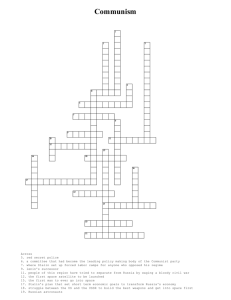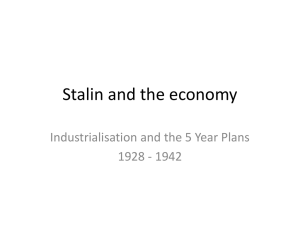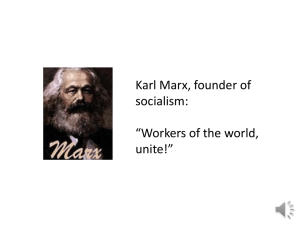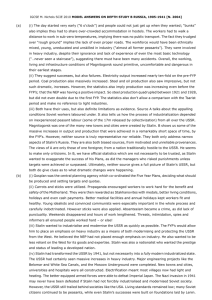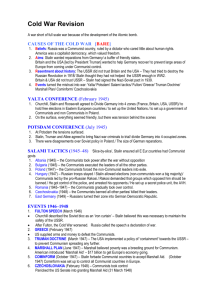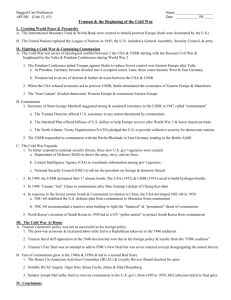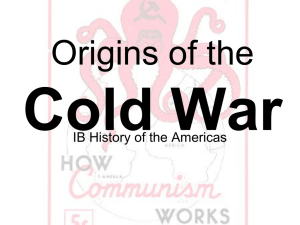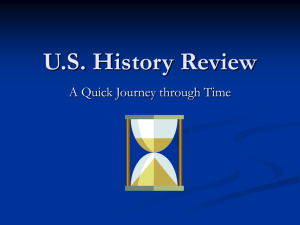Paper 1 Cold War 1945-60Revision
advertisement
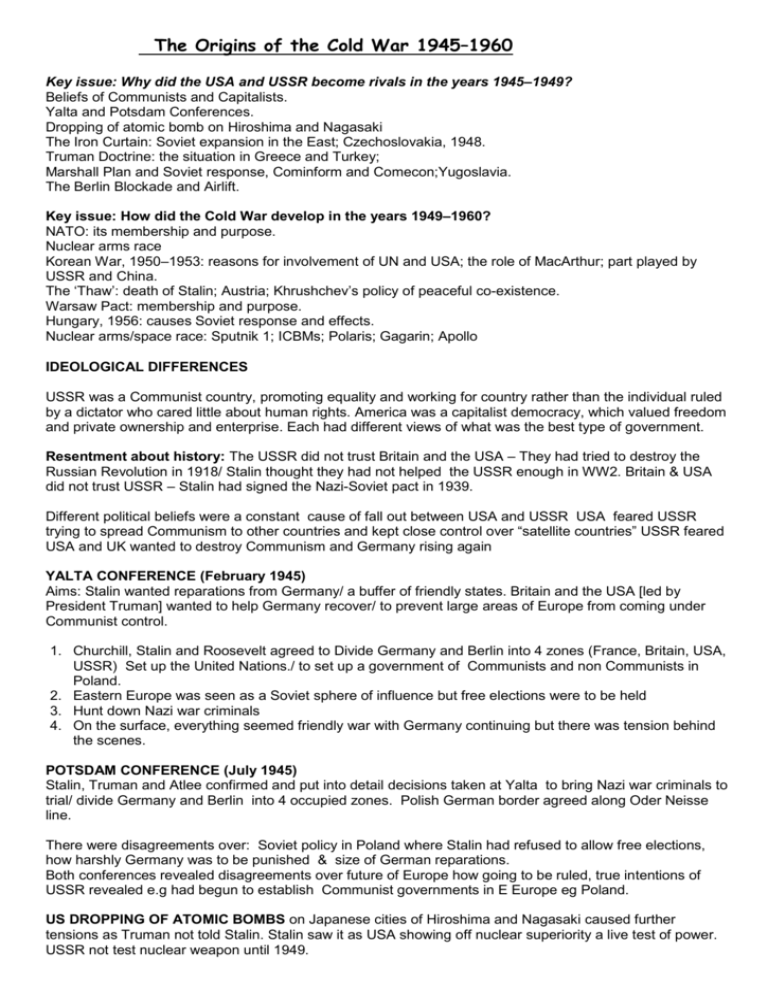
The Origins of the Cold War 1945–1960 Key issue: Why did the USA and USSR become rivals in the years 1945–1949? Beliefs of Communists and Capitalists. Yalta and Potsdam Conferences. Dropping of atomic bomb on Hiroshima and Nagasaki The Iron Curtain: Soviet expansion in the East; Czechoslovakia, 1948. Truman Doctrine: the situation in Greece and Turkey; Marshall Plan and Soviet response, Cominform and Comecon;Yugoslavia. The Berlin Blockade and Airlift. Key issue: How did the Cold War develop in the years 1949–1960? NATO: its membership and purpose. Nuclear arms race Korean War, 1950–1953: reasons for involvement of UN and USA; the role of MacArthur; part played by USSR and China. The ‘Thaw’: death of Stalin; Austria; Khrushchev’s policy of peaceful co-existence. Warsaw Pact: membership and purpose. Hungary, 1956: causes Soviet response and effects. Nuclear arms/space race: Sputnik 1; ICBMs; Polaris; Gagarin; Apollo IDEOLOGICAL DIFFERENCES USSR was a Communist country, promoting equality and working for country rather than the individual ruled by a dictator who cared little about human rights. America was a capitalist democracy, which valued freedom and private ownership and enterprise. Each had different views of what was the best type of government. Resentment about history: The USSR did not trust Britain and the USA – They had tried to destroy the Russian Revolution in 1918/ Stalin thought they had not helped the USSR enough in WW2. Britain & USA did not trust USSR – Stalin had signed the Nazi-Soviet pact in 1939. Different political beliefs were a constant cause of fall out between USA and USSR USA feared USSR trying to spread Communism to other countries and kept close control over “satellite countries” USSR feared USA and UK wanted to destroy Communism and Germany rising again YALTA CONFERENCE (February 1945) Aims: Stalin wanted reparations from Germany/ a buffer of friendly states. Britain and the USA [led by President Truman] wanted to help Germany recover/ to prevent large areas of Europe from coming under Communist control. 1. Churchill, Stalin and Roosevelt agreed to Divide Germany and Berlin into 4 zones (France, Britain, USA, USSR) Set up the United Nations./ to set up a government of Communists and non Communists in Poland. 2. Eastern Europe was seen as a Soviet sphere of influence but free elections were to be held 3. Hunt down Nazi war criminals 4. On the surface, everything seemed friendly war with Germany continuing but there was tension behind the scenes. POTSDAM CONFERENCE (July 1945) Stalin, Truman and Atlee confirmed and put into detail decisions taken at Yalta to bring Nazi war criminals to trial/ divide Germany and Berlin into 4 occupied zones. Polish German border agreed along Oder Neisse line. There were disagreements over: Soviet policy in Poland where Stalin had refused to allow free elections, how harshly Germany was to be punished & size of German reparations. Both conferences revealed disagreements over future of Europe how going to be ruled, true intentions of USSR revealed e.g had begun to establish Communist governments in E Europe eg Poland. US DROPPING OF ATOMIC BOMBS on Japanese cities of Hiroshima and Nagasaki caused further tensions as Truman not told Stalin. Stalin saw it as USA showing off nuclear superiority a live test of power. USSR not test nuclear weapon until 1949. IRON CURTAIN SPEECH (Fulton Missouri USA March 1946) Churchill described Europe as being behind divided by ‘iron curtain’ Behind te curtain – Stalin believed this was necessary to maintain the safety of the USSR. After Fulton, the Cold War worsened. Russia called the speech a declaration of war. Churchill always portrayed in USSR propaganda as being aggressive USSR TAKEOVER OF EASTERN EUROPE (1945–48 Stalin ensured all E Eur.countries had Communist govts 1. Albania (1945) – the Communists took power after the war without opposition 2. Bulgaria (1945) – the Communists executed the leaders of all the other parties. 3. Poland (1947) – the Communists forced the non-Communist leaders into exile. 4. Hungary (1947) – Russian troops stayed / Stalin allowed elections (non-communists won a big majority)/ Communists led by the pro-Russian Rakosi. Demanded that groups which opposed him should be banned./ He got control of the police, and arrested his opponents./ He set up a secret police unit, the AVH. 5. Romania (1945–1947) – the Communists gradually took over control. 6. Czechoslovakia (1948) – the Communists banned all other parties/ killed their leaders. 7. East Germany (1949) – Russians turned their zone into German Democratic Republic. Stalin believed it was necessary to maintain the safety of the USSR to Communist governments friendly and Capitalist. GREECE TURKEY (February/March 1947) US supplied arms and money to defeat the Communists when UK could not afford to help marked turning point in US policy not going to follow isolationist policy as had done after First World War. TRUMAN DOCTRINE (March 1947) – Speech to US Congress outlining reasons for sending money to Greece and Turkey became known as Truman Doctrine. The USA would implemented a policy of ‘containment’ towards the USSR – to prevent Communism spreading any further. They would help any country threatened by Communism MARSHALL PLAN (June 1947) – Put Truman doctrine into action General Marshall believed poverty was a breeding ground for Communism. Severe shortages and poor conditions across Europe ‘Marshall Aid’ – $17 billion to get Europe’s economy going. USA Congress only approved plan when Czechoslovakia became Communist. Majority of countries of west Europe got cash not just those directly threatened by Communism eg UK France as well as Turkey Greece. Yugoslavia got cash too USA staying in Europe, was selfish in some ways. USSR called it dollar imperialism, spreading influence and control by money COMINFORM (October 1947) – Stalin forbade Communist countries to accept Marshall Aid. 1947) Cominform was set up to control all Communist countries in Europe. (October COMECON USSR set up organisation to coordinate E European countries trade and economies CZECHOSLOVAKIA (February 1948) – Communists took control final straw in getting Marshall Aid Panicked the US Senate into granting Marshall Aid (31 March 1948) THE BERLIN BLOCKADE Causes Cold War was beginning to bite – created tension. Aims – USA+UK wanted Germany to recover/ Stalin looting German industrial capacity. Bizonia – USA, UK, France merged zones – became more prosperous than the Soviet. American Aid – Marshall Aid was voted 31 March 1948. New Currency –Britain and America introduced new currency – destabilised the East German economy. Stalin said that this was the cause of the blockade. Events: (24 June 1948) – Stalin closed rail + road links to Berlin / Lasted 11 months/ Allies airlifted supplies to Berlin – 275,000 flights, 1.5m tons/ In winter, Berliners lived on dried eggs and potatoes/ 4 hours of electricity a day./ US had B29 bombers on standby./ (12 May 1949) – Stalin re-opened the borders. Results: Cold War got worse. USSR upset by combining of zones and new currency. The blockade, trying to starve USA out of west Berlin was seen as spiteful act by West. Airlift by USA\UK frustrating for USSR as powerless to do anything shooting down planes seen as an act of war. West Berlin staying capitalist Sparked creation of East/West Germany: Division of Germany confirmed as “officially 2 separate countries. NATO (1949) defensive alliance against being attacked. Attack on one attack on all Members USA Canada France/ UK/ Belgium/ Netherlands/Iceland etc later Turkey and Greece and West Germany joined. USA committing militarily to support countries in Europe. WARSAW PACT 1955 by Communist version of NATO in response to West Germany beign admitted to NATO USSR/ Albania/ Bulgaria/ Czechoslovakia/ E Germany/ Hungary/ Poland/ Romania. KOREAN WAR (North Korea [Communist] invaded South Korea [Capitalist]) Causes Domino theory – Truman thought that Far Eastern countries would fall like dominoes. China Communist (1949). Truman feared Japan would follow. Undermine Communism – The National Security Council recommended (NSC 68 – April 1950) abandoning containment to ‘roll back’ Communism. Korea a ‘war at arm’s length’. Kim Il Sung North Koreas leader – got Stalin’s and Mao tse Tung’s agreement to attack South Korea. Events By June 1950 – the NKPA captured most of South Korea. South Korea appealed to United Nations for assistance. USSR boycotting meetings- Security Council able to pass resolution promising assistance July 1950 – Inchon landings by UN troops behind enemy lines planned by General MacArthur were risky but brilliantly executed. At same time UN troops pushed out of Pusan pocket. drove the North Korean army back past the original border and towards the Chinese border. October 1950 – China attacked/ drove the Americans back/ advanced into South Korea. MacArthur underestimated Chinese threat March 1951 – American reinforcements drove back Chinese (200,000 dead). Truman told the troops to stop at the 38th parallel. Macarthur ignored and openly talked of attacking China mainland. MacArthur sacked by Truman for opposing his policy of containment. July 1953 – Truce: Consequences of Korean War 30,000 US soldiers killed, 4,500 other UN soldiers killed. 150,000 Chinese soldiers and 215,000 North Korean soldiers. 70,000 South Korean soldiers . America claimed successful containment of Communism. Stalemate. Korea still split in 2. Cold War spread to Asia, First actual war. China got involved. Talk of using nuclear weapons scared some. UN more effective than old League of Nations KHRUSHCHEV succeeded Stalin. 1953 It seemed he would bring a thaw in the Cold War – He advocated ‘Peaceful Coexistence’/ He met Western leaders at summit meetings/ He was friendly to Yugoslavia, telling Tito there were ‘different roads to Communism’/ He criticised Stalin, executed Beria, set free political prisoners and de-stalinised USSR. Changing places named after Stalin removing statues etc Removed Soviet troops occupying Austria May 1955. By peaceful co-existence, Khrushchev meant ‘peaceful competition’ (He loved to argue (Kitchen debate with Nixon)/ He gave economic aid to countries like Afghanistan and Burma / Arms Race and space race continued. HUNGARY (1956) Causes: Poverty – Most of Hungary’s food was sent to Russia Russian Control – The Hungarians were very patriotic/ They hated censorship, the AVH (secret police) and Russian control of education./ They hated having Russian troops stationed in Hungary Catholic Church – Communism tried to destroy religion, but lots Hungarians were Catholics Help from the West – The Hungarians thought Eisenhower or UN would help.Destalinisation –Led to protests against Rakosi’s harsh government. Events 23 October – Student riots – attacks on AVH and Russian troops 24 October – 3 November – Reforming government led by Imre Nagy (Democracy/ Freedom of speech/ Freedom of religion/ Aimed to withdraw from Warsaw Pact. 4 November – Soviets sent 1000 tanks to crush/ Western powers protested but didn’t much else want a war. Results Janos Kadar put in control of Hungary/ 27,000 Hungarians killed/ Nagy shot./ 200,000 Hungarians flee to West./ Many westerners leave the Communist party./ Russia stays in control in Eastern Europe./ Western leaders all the more determined to ‘contain’ communism spreading. Showed toughness of Khrushchev USA not intervene had to accept Hungary and Eastern Europe Soviet sphere of influence . Cold War got worse NUCLEAR ARMS RACE 1945- 1960 Until 1949 only USA had Atomic Bomb. They had used two against Japan in 1945 1950 USSR announced they had Atomic Bomb 1952 America developed more powerful Hydrogen bomb 1953 USSR developed Hydrogen bomb 1953 US sent battlefield nuclear weapons to US Army in West Germany USA always concerned about numerical superiority of Warsaw Pact forces 1957 USSR and USA develop ICBM-Intercontinental Ballistic Missile. Rocket with own engine and fuel no pilot with nuclear warhead to fire from USSR to USA USA to USSR 1959 USA develops Minuteman ICBM , ready to fire in 30 seconds 1960 USA develops Polaris Submarines capable of firing nuclear missiles 1960 USSR develops own submarines capable of firing nuclear missiles SPACE RACE Important as competition to see who was best system of Government but also space technologies (rockets) could be used in arms race . Early USSR lead in space race but USA caught up due to larger financial resources. Kennedy had set NASA a task of landing a man on the moon by the end of the 1960s Apollo Programme 1957 First artificial satellite in space – Sputnik USSR 1961 First manned spaceflight (Yuri Gagarin) USSR 1961 First American in space Alan Shepherd USA

